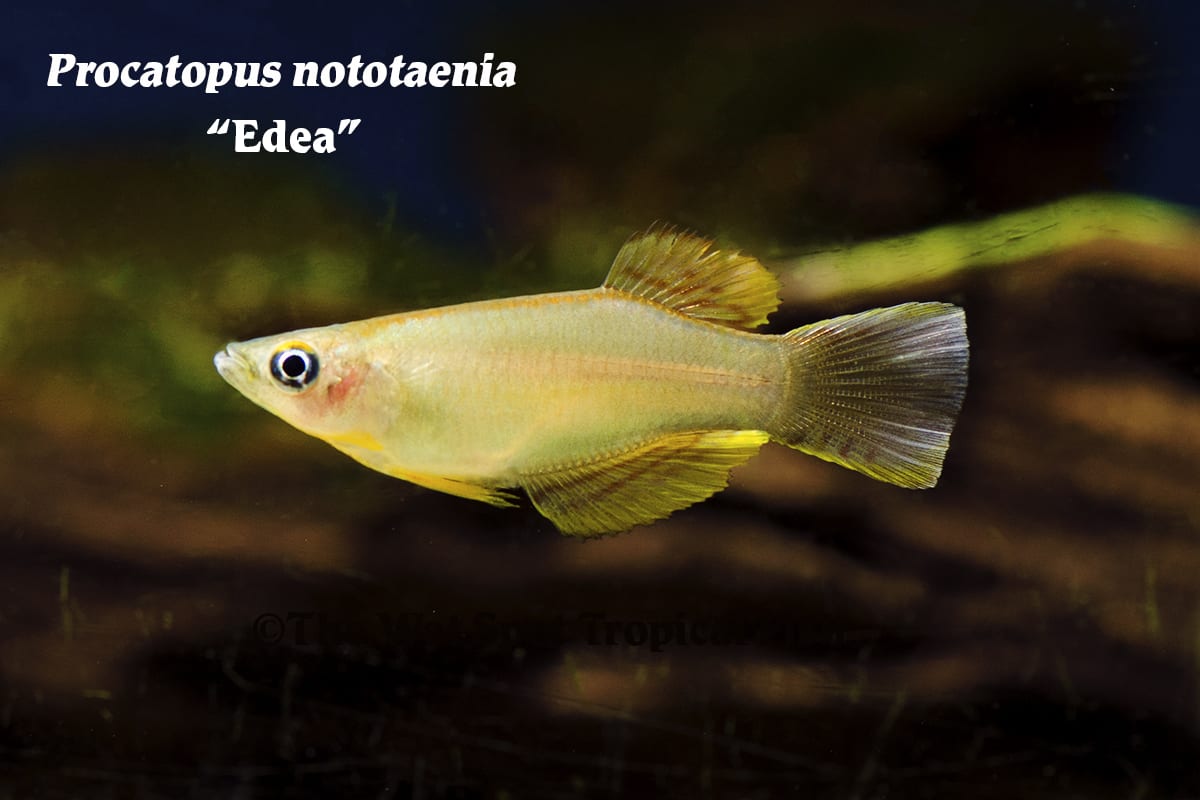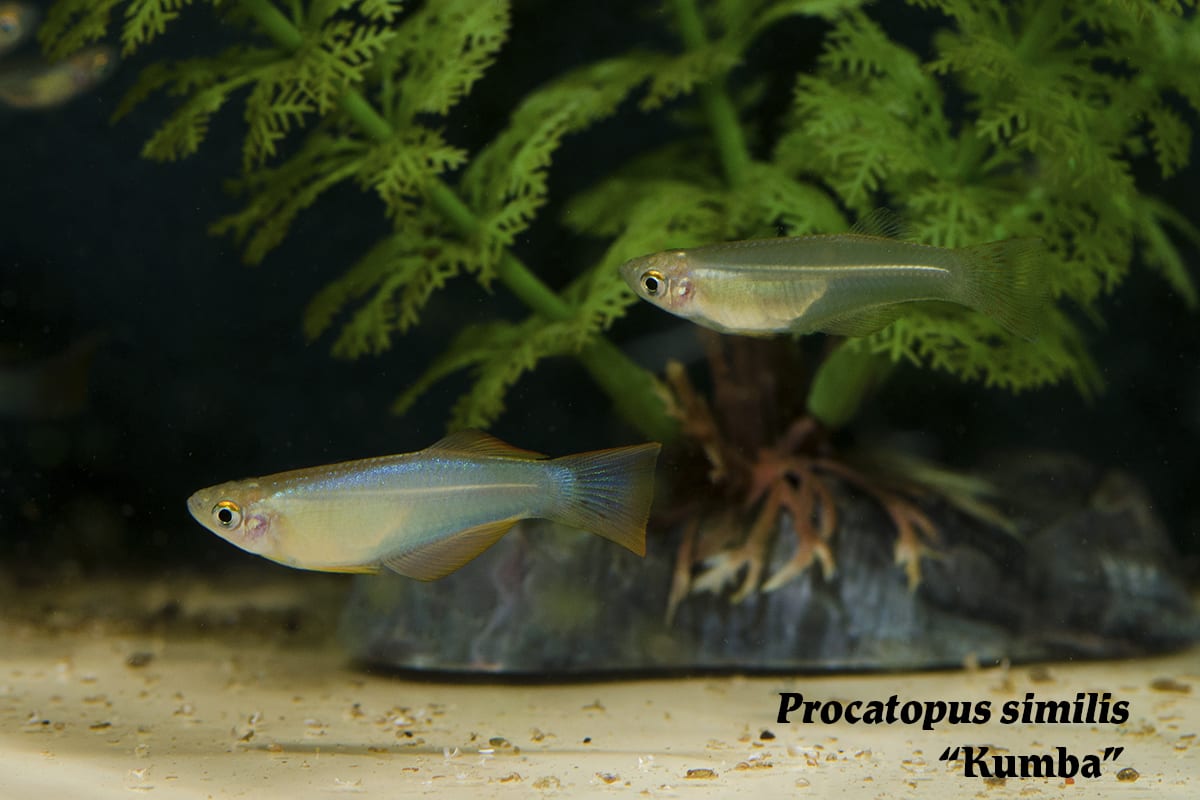Make It! Aquaria Edition
Make it! Aquaria Edition
It’s no secret many of the most unique and beautiful freshwater fish in the aquarium hobby originate from the diverse habitats of Africa. In fact, there are an estimated 1,600 cichlid species thriving in the collective 31,000 cubic kilometers contained within the great lakes of the African continent. It’s also no secret that African cichlids require a certain level of knowledge, attention, and diligence related to their aggression, and keeping peace between inhabitants can be quite a task! And, quite frankly, sometimes the greatest joy we aquarists can derive is from putting together a beautifully aquascaped, peaceful community tank. Luckily, we don’t need to leave Africa to find suitable, small community species, we just need to swim a little upstream. The rivers of central and western Africa are their own hotbed of fishy goodness including this weeks’ 3: Enteromius hulstaerti, Procatopus nototaenia “Edea”, and Procatopus similis “Kumba”.
Scientific NameEnteromius hulstaerti
Common NameButterfly Barb
Temperature / pH63 to 75°F / 5.0 to 6.5 pH
Native LocationCongo drainage
Preferred DietSmall invertebrates
Found swimming through the slow-moving stretches of forest streams in the Congo River drainage, E. hulstaerti is the perfect choice for blackwater aquascapes. This beautiful little characin thrives in planted tanks (think low light like Anubias, Cryptocoryne, and floating vegetation) with soft water, sandy substrate, tannin-stained waters from dried leaf litter, driftwood stripped of bark, and wooden tangles arranged to form interesting labyrinths. Reaching just under an inch and a half in length, these “Butterfly Barbs” are pale in coloration with 3 large, dark spots along their sides, and yellow, and black striped fins. Peaceful and somewhat skittish, these barbs do best in tanks with other peaceful African species of similar size like Aplocheilichthys spp., Ladigesia roloffi, and Lepidarchus adonis. Additionally, they can be kept alongside peaceful catfish, otos, and cories. Gregarious and shoaling by nature, it is best if they are in groups of 8 or more, so long as they have plentiful swimming space, otherwise, they do fine in small harems in more confined tanks. Feeding mostly on aquatic invertebrates and insect larvae in the wild, they should be fed regular meals of small live and frozen fare, and will also accept high-quality dried foods. Tank waters are best maintained with temperatures between 63 and 75°F, pH of 5.0 to 6.5, and hardness of 18 to 90 ppm.
Scientific NameProcatopus nototaenia “Edea”
Common NameNototaenia Killi
Temperature / pH68 to 77°F / 5.8 to 7.5 pH
Native LocationCameroon
Preferred DietSmall invertebrates
Endemic to the shady streams and of the Senaga river near the city of Edea in Cameroon, P. nototaenia “Edea” prefers clear, flowing waters with dense marginal and overhanging vegetation. Known more commonly as “Nototaenia Killifish”, these poeciliids do best in densely planted aquascapes, including floating plants, with plentiful shady refuges. Tanks should be set up with coarse gravel, filtration systems, and furnishing structures that break the surface to create desired flow, just make sure to keep a tight lid to prevent these talented jumpers from getting out. Sensitive to water quality, 10-20% water changes should occur frequently. This killi exhibits size dimorphism between the sexes, and males reach about 2.5 inches, while females stay around 1.5. They have beautiful upturned noses and elegantly swooping silver bodies with red and blue patterned fins, and shining eyes. The perfect choice for African stream community tanks, they are peaceful, and do well alongside other peaceful species of similar size including Alestiid characins, garras, stream loaches, and peaceful catfish. Schooling by nature they should be kept in groups of at least 8, with larger displays appearing much more impressive. Their natural diets consist of small invertebrates eaten at the surface, and they should be fed mostly live and frozen foods. Keep tank waters with temperatures of 68 to 77°F, pH between 5.8 and 7.5, and hardness within the range of 18 to 180 ppm.
Scientific NameProcatopus similis “Kumba”
Common NameSimilis Killi
Temperature / pH75 to 79°F / 6.0 to 8.0 pH
Native LocationCameroon
Preferred DietSmall invertebrates
Another Procatopus species, these “Similis Killifish” are observed in the Kumba region of western Cameroon. They are found in fast-flowing streams where they are benthic feeders, enjoying morsels from the bottom, and mid waters. Tanks are best setup mimicking their flowing river habitat with high levels of oxygenation. They do best with dark substrate, low lighting, floating plants, scattered vegetation, and plenty of open swimming space in the mid region of the tank. Again, be sure the tank is fitted with a tight lid since these killis are jumpy as well. Reaching up to 2.5 inches, they are narrow-bodied with pointed faces, a light blue-green sheen, and red-tipped fins. Males tend to be slightly large in body and more brightly colored. A more difficult killifish to keep, they are extremely sensitive to water chemistry fluctuations, which makes maintenance a slightly more challenging task. They are, however, perfectly peaceful, and can be kept in community aquaria with tank-mates like danios, hill stream loaches, characins, and loricariids. Schooling by nature, they should be kept in conspecific groups of 6 or more. In the wild they feed predominantly on aquatic invertebrates including crustaceans, insects, and river worms. In captivity they do best when fed regular meals of small, live and frozen foods. Tank waters are best maintained with temperatures between 75 and 79°F, pH of 6.0 to 8.0, and hardness between 90 and 214 ppm.
Setting up a small community tank can be as challenging and creative a task as you’d like to make it. We find aquascaping incredibly fulfilling, and the fish certainly appreciate our extra effort. Whether or not you’re looking for an African river or brackish theme, we’re here to help you set up a community tank you’ll feel proud to walk past.


